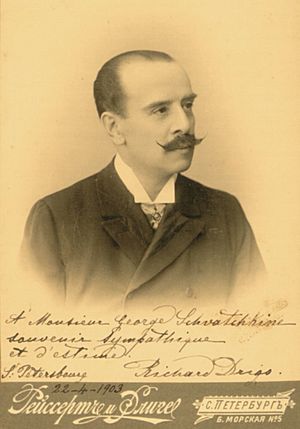Riccardo Drigo facts for kids
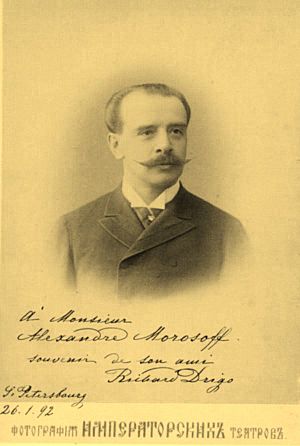
Riccardo Eugenio Drigo (born June 30, 1846 – died October 1, 1930) was an Italian composer of ballet music and Italian opera. He was also a talented conductor and pianist.
Drigo is best known for his long career in Saint Petersburg, Russia. He was the main conductor and music director for the Imperial Ballet. He wrote music for new ballets and helped update older ones for famous choreographers like Marius Petipa and Lev Ivanov. Drigo also conducted Italian opera performances at the Mariinsky Theatre. During his time in Saint Petersburg, he conducted almost every ballet and Italian opera shown on the Tsar's stage.
Many of Drigo's original ballet compositions are still performed today. He also wrote lots of extra music to add to existing ballets. He even updated famous scores, like Pyotr Ilyich Tchaikovsky's Swan Lake in 1895. His music is a key part of classical ballet.
Contents
Early Life and Career
Riccardo Eugenio Drigo was born in Padua, Italy, on June 30, 1846. His father, Silvio Drigo, was a lawyer, and his mother was involved in politics. No one else in his family was a musician. However, Riccardo started piano lessons at age five with a family friend, Antonio Jorich.
Drigo quickly became very good at the piano. By his early teenage years, he was well-known locally as a pianist. His father allowed him to attend the famous Venice Conservatory. There, he studied with Antonio Buzzolla, who was a student of the famous composer Gaetano Donizetti.
Drigo wrote his first songs, mostly romantic pieces and waltzes, when he was a teenager. In 1862, he got to play some of his music with a local orchestra in Padua. This experience made the young Drigo interested in conducting.
His first job in an opera house was in 1866 at the Garibaldi Theatre in Padua. He worked as a rehearsal pianist and copied music. His big chance to conduct came in 1867. The theatre's main conductor got sick right before the premiere of an opera called I Due Orsi. The lead violinist suggested Drigo conduct because he knew the music well. Drigo's conducting was a success, and he soon became the second main conductor.
In 1878, the director of the Saint Petersburg Imperial Theatres, Baron Karl Karlovich Kister, saw Drigo conduct an opera. Kister was very impressed because Drigo conducted without looking at the music. Drigo then showed Kister some of his own compositions. This led Kister to offer Drigo a six-month contract to conduct the Imperial Italian Opera in Saint Petersburg.
Life in Russia
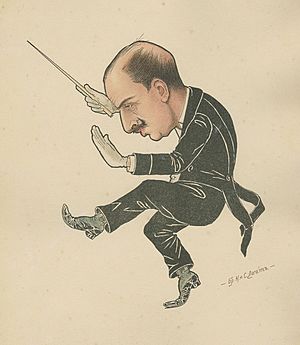
When Drigo arrived in Saint Petersburg, he immediately started conducting all the operas for the Imperial Italian Opera. They performed at the Mariinsky Theatre. He impressed everyone by conducting operas like Verdi's Aida and Un ballo in maschera from memory. Newspapers in Russia always reported on theatre performances. Drigo's performances always received praise. One writer commented, "... the young gentleman will stay here a long time ..."
A Famous Composer and Conductor
In 1884, Emperor Alexander III closed the Imperial Italian Opera. He wanted to focus more on Russian opera. This left Drigo without a job. But in 1886, the main conductor of the Saint Petersburg Imperial Ballet retired. Drigo took over this important role.
He made his debut as a ballet conductor on October 7, 1886. He conducted the ballet The Pharaoh's Daughter, which was very popular. The Emperor and Empress Maria Fyodorovna were there. They loved ballet and spent a lot of money on the Imperial Theatres. The Emperor was so impressed with Drigo's conducting that he gave him a standing ovation and told everyone else to do the same!
The Imperial Theatre's official ballet composer, Ludwig Minkus, also retired in 1886. The director, Ivan Vsevolozhsky, decided not to hire a new full-time composer. Instead, he made Drigo both the main conductor and the Director of Music. This meant Drigo would also adapt and fix music for new ballets when the Ballet Master asked him to.
The famous Ballet Master, Marius Petipa, brought back an old ballet called La Esmeralda in 1886. He did this for a visiting Italian ballerina named Virginia Zucchi. Drigo was asked to update the old music. He wrote a special four-part dance called a Pas d'action for Zucchi. It had difficult solos for violin and cello, with the violin part written for the great Leopold Auer. The updated La Esmeralda was a big success. Drigo's Pas d'action is still part of La Esmeralda today.
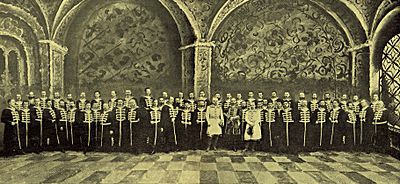
Because his work on La Esmeralda was so successful, Drigo was asked to compose a complete ballet score. This was for La Forêt enchantée (The Enchanted Forest). It was Drigo's first full-length ballet and the first original work by the new second Ballet Master, Lev Ivanov. The ballet was for the annual graduation show of the Imperial Ballet School. It premiered on April 5, 1887, and later moved to the Mariinsky Theatre. Even though Ivanov's choreography wasn't loved, Drigo's music was highly praised.
In 1888, Petipa was working on his ballet La Vestale. The music was by Mikhail Ivanov. The lead ballerina, Elena Cornalba, wanted more dance-friendly music for her solos. She had seen La Forêt enchantée and asked Drigo to write these extra dances. Drigo composed two variations for her, called L'echo and Valse mignonne. He also wrote a variation for the character Cupid.
Major Ballets
Le Talisman
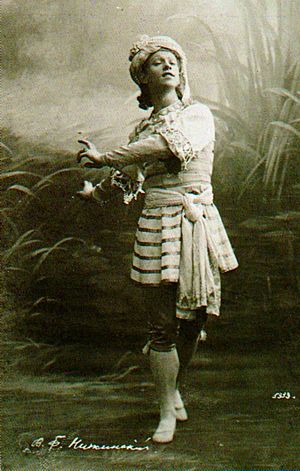
For Elena Cornalba's next ballet, she asked Drigo to compose the entire score. This ballet was Le Talisman (The Talisman). It told the story of a Hindu Goddess who comes to Earth to experience love. The ballet premiered on February 6, 1889. Even though the show was grand, critics found the story a bit boring. However, Drigo's music was called a masterpiece.
Over the years, Drigo was often asked by Petipa and Ivanov to write extra dances for older ballets. By the time he left Russia in 1919, almost every ballet in the Imperial Theatres had extra music by Drigo. He later said he wrote about 80 such pieces, often without extra pay.
In 1889, Drigo moved into the Saint Petersburg Grand Hotel, where he lived for the next thirty years. Around this time, he became close friends with Pyotr Ilyich Tchaikovsky, who was writing the music for Petipa's The Sleeping Beauty. Drigo conducted the premiere of The Sleeping Beauty on January 15, 1890. Tchaikovsky was very grateful for Drigo's excellent conducting. Drigo ended up conducting almost 300 performances of The Sleeping Beauty. Two years later, Drigo also conducted the premiere of Tchaikovsky's The Nutcracker on December 18, 1892.
The Magic Flute and The Awakening of Flora
Drigo composed another ballet for the Imperial Ballet school's graduation in 1893. This was the one-act ballet La Flûte magique (The Magic Flute). It was about a magical instrument that made everyone dance when it was played. Lev Ivanov staged it, and it premiered on February 4, 1893, to great success. A young Mikhail Fokine played the lead role. Because it was so popular, The Magic Flute was later performed at the Mariinsky Theatre.
Drigo's next ballet was Le Réveil de Flore (The Awakening of Flora), staged by Petipa. This one-act ballet was created for the wedding celebrations of Grand Duchess Xenia Alexandrovna and Grand Duke Alexander Mikhailovich at Peterhof Palace. The premiere on August 6, 1894, was a grand event with the entire Imperial court watching. For his music for Le Réveil de Flore, Emperor Alexander III gave Drigo the Order of St. Anna.
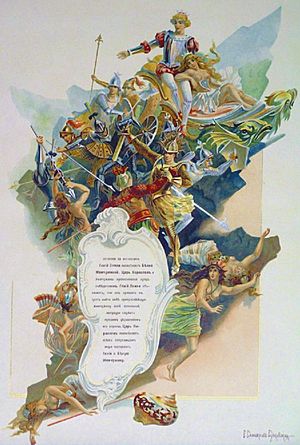
Like The Magic Flute, The Awakening of Flora moved to the Mariinsky Theatre. It became a favorite of ballerinas like Mathilde Kschessinska and Anna Pavlova. Pavlova even took a shorter version of it on her world tours.
Swan Lake
In late 1894, Drigo worked on a very important update of Tchaikovsky's music for Swan Lake. The original ballet was first performed in 1877. After the success of The Sleeping Beauty and The Nutcracker, the director Ivan Vsevolozhsky wanted to bring Swan Lake back.
Tchaikovsky had passed away in 1893, just as plans for the Swan Lake revival began. Tchaikovsky's brother, Modest, agreed that Drigo should update the music. Drigo followed Petipa's instructions for the changes.
The updated Swan Lake premiered on January 27, 1895, at the Mariinsky Theatre. The famous ballerina Pierina Legnani danced the main roles of Odette and Odile. Drigo's version of Tchaikovsky's music is still the main one used by ballet companies around the world today. However, Drigo often doesn't get credit for his important changes.
La Perle
Drigo's next ballet score was for the grand show La Perle (The Pearl). This ballet was created for a special celebration at the Imperial Bolshoi Theatre of Moscow. It honored the coronation of Tsar Nicholas II and Empress Alexandra Fyodorovna. The ballet premiered on May 29, 1896.
Les Millions d'Arlequin
In 1899, Petipa started a ballet based on Italian comedy characters, called Les Millions d'Arlequin (The Millions of Harlequin). It premiered at the Imperial Theatre of the Hermitage on February 23, 1900. Mathilde Kschessinska played Columbine. The audience, including the Emperor and Empress, loved it. Drigo received huge applause and congratulations for his music.
The Empress loved Drigo's music so much that she ordered two more performances of Les Millions d'Arlequin at the Mariinsky Theatre. When Drigo's music was going to be published, his friends encouraged him to dedicate it to the Empress. After a long process to make sure he was worthy, the dedication was accepted.
Later Years and Return to Italy
In 1902, Drigo and some Imperial Ballet dancers were invited to perform in Monaco. Drigo composed music for a ballet called La Côte d'Azur (The French Riviera). It premiered on March 30, 1902.
Drigo's last original full-length ballet score was also Marius Petipa's final work. It was called La Romance d'un Bouton de rose et d'un Papillon (The Romance of a Rosebud and a Butterfly). It was supposed to premiere on February 5, 1904, but was canceled because World War I started.
Drigo was on vacation in Italy when World War I began in 1914. He couldn't return to Russia for two years. When he finally got back to Petrograd (Saint Petersburg), he was forced out of his home at the Grand Hotel. It was turned into offices for the new Soviet government. For a while, Drigo lived in poverty with other Italians. He remembered cold evenings waiting in bread lines with his friend Alexander Glazunov. When he first conducted again at the Mariinsky Theatre, the audience gave him a fifteen-minute standing ovation.
In 1919, Drigo was finally able to return to Italy. For his farewell show, the Ballet Master Fyodor Lopukhov staged a new version of Drigo and Petipa's last ballet. At the end of the show, the famous singer Feodor Chaliapin read a heartfelt farewell speech in both Italian and Russian. Drigo was only allowed to take 60 kilograms of belongings. He left everything else in Russia except for his music manuscripts, which he used as a pillow during his two-month journey home.
In 1920, Drigo became the main conductor at the Teatro Garibaldi in Padua, where he had started his career. In 1926, he composed a comic opera called Flaffy Raffles. His last work, the opera Il garofano bianco (The White Carnation), was performed in 1929. He spent the rest of his life conducting and composing music.
Riccardo Drigo passed away on October 1, 1930, at the age of 84, in his hometown of Padua. There is now a street in Padua named Via Riccardo Drigo in his honor.
Works
Operas
- Don Pedro di Portogallo. July 25, 1868, Padua.
- La Moglie Rapita. March 6, 1884, Imperial Mariinsky Theatre.
- Flaffy Raffles. 1926, Padua.
- Il Garafano Bianco. 1929, Padua.
Ballets
- La Forêt enchantée. April 5, 1887, Imperial Ballet School.
- Le Talisman. February 6, 1889, Imperial Mariinsky Theatre.
- La Flûte magique. February 4, 1893, Imperial Ballet School.
- Le Réveil de Flore. August 8, 1894, Imperial Theatre of Peterhof.
- La Perle. May 29, 1896, Imperial Bolshoi Theatre of Moscow.
- Les millions d'Arlequin (also known as Harlequinade). February 23, 1900, Imperial Theatre of the Hermitage.
- La Côte d’Azur. March 30, 1902, Monte-Carlo.
- La Romance d'un Bouton de rose et d'un Papillon. February 5, 1904, Imperial Theatre of the Hermitage (never premiered).
Revisions to Existing Scores
- La Esmeralda, 1886. Original music by Cesare Pugni.
- Swan Lake, 1895. Original music by Pyotr Ilyich Tchaikovsky.
See also
 In Spanish: Riccardo Drigo para niños
In Spanish: Riccardo Drigo para niños


